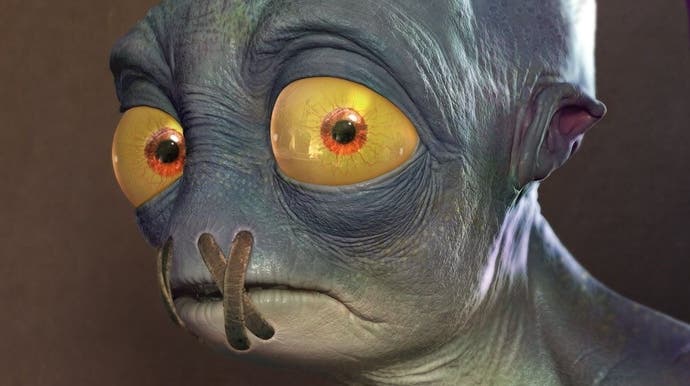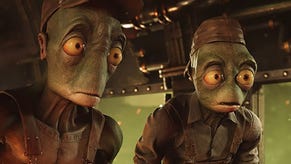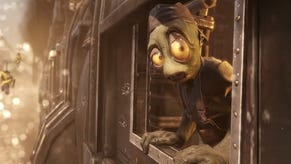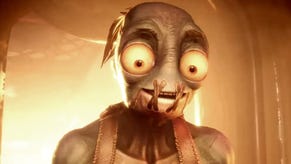Oddworld: Soulstorm - the quintology is back on
"Today, there are more slaves on planet Earth than there ever were..."
"Today, there are more slaves on planet Earth than there ever were in world history combined..."
40.3 million people in 2016, to be precise, there in plain sight, all around us.
"Who are these people to be put through hell? And what if one of those broke out, inspired their people and it led to uprisings, rumours, uneasiness and disruption, which would eventually spark a revolution which would topple financial markets through the disruption of commerce and produce and trade?"
What if?
"More slaves on planet Earth than there ever were in world history combined…" This is how Lorne Lanning rolls when it comes to video games. Nothing should be off-topic for video games. More video games should use those secret ingredients - interactivity, empathy - in the service of things that truly matter in the world. This is part of the brilliance of Oddworld, why the series grabs people so strongly even after all these years. It's why, more than two decades after the first game was released, people still flock to hear creator Lorne Lanning talk. There's a magic here.
"Why don't we set forth to see if we can't ... get the quintology done in our lifetimes." -Lorne Lanning
But the magic was nearly lost.
To put it another way: once upon a time there was a dream. Five games, one character, one Oddworld.
"I looked at a world where I thought people were getting disengaged from what they saw happening on a global landscape," Lorne Lanning explains to me over Skype. "Politicians could no longer be trusted, corporations could no longer be trusted, pharmaceuticals and medicine could no longer be trusted, law enforcement was questionable. The world was increasingly becoming more Orwellian."
(As if, Lorne, as if!)
That "what if?" became Abe's story.
"Abe, this lowly slave, would slowly start having an impact on the major economic forces of the world and really start fucking shit up," Lanning says. "And then the holy hell of the law, the political landscape, the fake news media - all of it would come raining down on him. And he would become labelled 'the Bin Laden of Oddworld', the public enemy number one, who's causing everyone's Happy Meals to go up 200 per cent in price - the unforgivable! Your coffee's more expensive: unforgivable! Kill that guy!
"That," adds Lanning, "was the essence of Abe."
And in Abe's Odyssey, the debut release in 1997, that essence was intact. "Of all the games we built, Abe's Odyssey was the purest vision in terms of the overall Oddworld quintology," he tells me. On the back of the box it apparently even said Abe's Odyssey would be the first of a five-part series. Remaking Abe's Odyssey, then, made perfect sense, so Oddworld Inhabitants did exactly that with Oddworld: New 'n' Tasty in 2014, and it was good. Very.
Its success bred the natural assumption Oddworld Inhabitants would go on to give Oddworld game number two, Abe's Exodus, the same treatment. Fans were apparently polled and wanted it - we even assumed that was the case when Soulstorm was first announced in 2016 (for 2017 release, ho ho). But there was a problem - another big but (I wish I hadn't used that phrase now).
"We were like, 'Ah shit, man!'" Lanning says. "Exodus was the one that took us off track. That's the one we had to get done in nine months. It killed me. It was a horrible memory. It was just terrible - I aged like 15 years on it."
You know this story. The success of Abe's Odyssey was "a curse". "The curse was we were taken off course from what our plans were, which was to build the second part of the quintology," Lanning tells me. “Abe was a success, great - we had carved our way into the industry. Now I thought, naively, that was going to buy me the time - another two and a half years - to build part two. But that's not what happened."
Instead, publisher GT Interactive wanted another game out pronto. Abe's Odyssey had saved Christmas and GT wanted a repeat performance the following year. (The irony of a game as passionately furious as Abe's Odyssey being drafted in to save Christmas was presumably not lost on Lanning.)
"We were asked like your wife might ask you - we were 50 per cent partners so I can't really say we were told - 'Why don't you just do part two and do it in nine months because we need it for next Christmas? You're the only ones we can rely on, you're the only ones who came through for us, and we need to count on you next year."
So, reluctantly, Lanning agreed, knowing full well he couldn't build what he wanted. And that - "that was the beginning of us getting derailed off what the original vision of the Oddworld quintology was." A fan described Exodus, released in 1998 as instructed, as being twice the game but having half the heart, "And as much as it stung with me, I really had to agree with that."
But Soulstorm, as I said, represented a chance to do over - to go back and do it properly, to "bite the bullet and go back to that original vision". So that's what Soulstorm is: the quintology resurrected, ignoring all the games that followed Exodus. ("They're valid for the world but we wanted to bring Abe back to his real, true mission, as Abe is the centre character throughout.") Part two as it was always meant to be. "And if we're going to do that," Lanning adds, "why don't we set forth to see if we can't, before we get much greyer, get the quintology done in our lifetimes."
Soulstorm, when demoed to me, looks great. I see a vertical slice, so a level polished to final quality levels in order to demonstrate what the rest will hopefully be like. I'm told there are four or five levels built to this quality, and 20 levels in all - around 15-20 hours if played through at a considerable lick (but that would ignore all the achievements and trophies and scores related to level completion which are baked in for replayability's sake).
The buzzword for Soulstorm is "2.9D". Remember when Shadow Complex came out and shouted about 2.5D? It meant it was a side-on game with 3D depth to it. Soulstorm is like that, only more. It's there in how the game has a middle-ground and background behind the platform you're currently on, and how those are actual parts of the level you will at some point get to - a fancy kind of foreshadowing. Or it's there in how the game sometimes spins on its axes to present the action from a different perspective - with trains hurtling towards the screen and you and your followers having to perform a terrifying kind of Frogger. Or it's there in little touches like lockers facing the camera you and your followers can temporarily hide in to avoid guards.
The other big focus is physics, and with it the unpredictability a destructible environment can bring. This is central to the game, as it ties into the core crafting and scavenging gameplay idea. Abe works to a kind of "homeless economy", Lanning explains, scrounging bottle tops for recycling money and repurposing scraps and soft drinks to fashion an improvised, Anarchist's Cookbook kind of arsenal.
Dirty rags and lighters and wires can combine with things like the vile fizzy Brew drink to make molotov cocktails, for instance. Or you can simply plop an equally vile sweet into the drink and watch it pop - think Pepsi and Mentos, Lanning says. And the booms and fires you create eat away at the structural parts of the level around you, eventually bringing them tumbling to the ground.
Crafting means Abe has an inventory now too, to store the things he creates, and he can share his creations with the followers he rescues, arming them for encounters ahead. There's a particularly eye-catching section in the demo involving an on-rails lift with enemies everywhere, you controlling a mounted gun while your followers lob explosives.
But while your Lemmings-like followers might be helpful in a pinch, they're unwieldy while you try to sneak past guards. Sooner or later you'll be spotted and alarms will sound and guns will fire, and your followers will fall. How many Mudokons can you ultimately liberate? Therein lies the challenge.
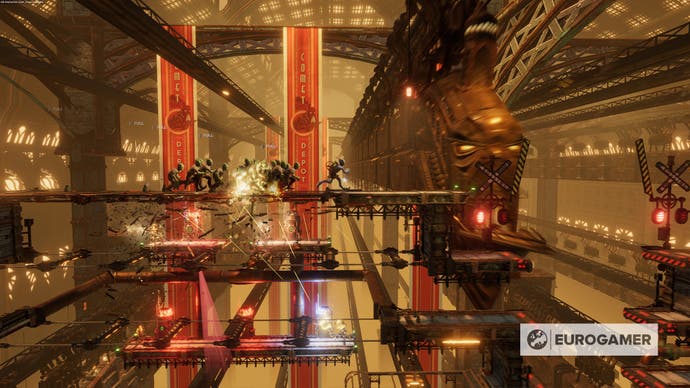
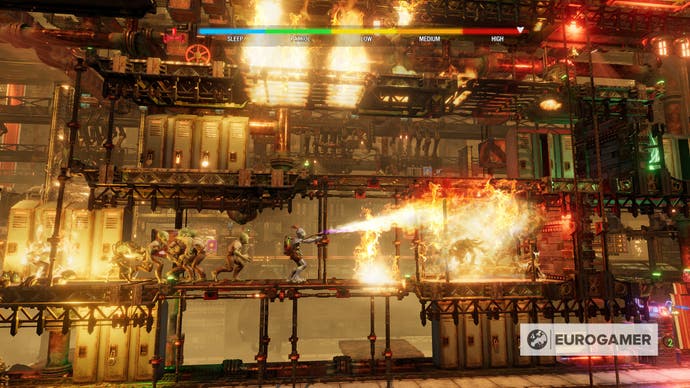

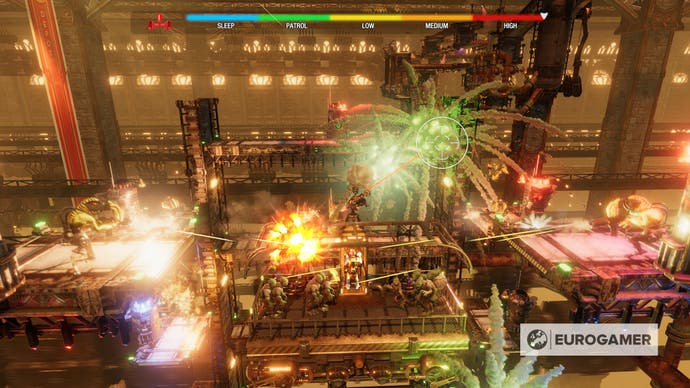

It's a slick showing, cinematics merged into gameplay, which you can glimpse a bit of in the new, embedded trailer. And while I didn't play the demo, it looked responsive and fun. What's more, if Lanning's talk of Soulstorm being a true second part to the quintology bears fruit, it should be politically poignant as well.
But we'll see. There's still a year to go, and while Lanning's adamant he won't rush anything out - "we'll be forgiven for being late ... as long as the game is great, but if we show up and ship on time and the game's not great, we'll be slaughtered forever" - it's still an ambitious project. Despite Lanning's fearsome intelligence and battle-hardened confidence, this is a tricky time to be making one politically-charged indie game, let alone one with the power to resurrect an aging "quintology". If you want an example of how tricky it can be, when I spoke to Lanning Soulstorm was aiming to launch on the crowd-funding platform Fig. As I write this, Fig is out, which hopefully means funding has been sourced from elsewhere.
From where? Epic would be an easy guess, given the state of the industry. Nevertheless, Oddworld: Soulstorm is back on the radar. And, whisper it, the Oddworld quintology is back on.
